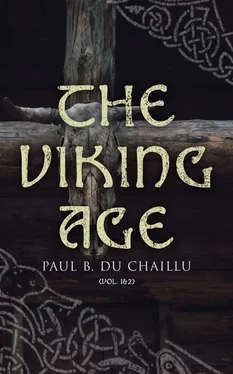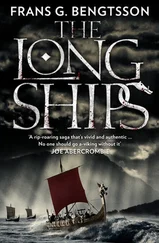These are but a few of many allusions to the same effect which might be quoted.
That the swarms of Sueones and so-called Saxons and Franks, seen on every sea of Europe, could have poured forth from a small country is not possible. Such fleets as they possessed could only have come from a country densely covered with oak forests. We must come to the conclusion that Sueones, Franks, and Saxons were seafaring tribes belonging to one people. The Roman writers did not seem to know the precise locality inhabited by these people.
It would appear that these tribes must have come from a country further eastward than the Roman provinces, and that as they came with ships, their home must have been on the shores of the Baltic, the Cattegat, and Norway; in fact, precisely the country which the numerous antiquities point to as inhabited by an extremely warlike and maritime race, which had great intercourse with the Greek and Roman world.
The dates given by the Greek and Roman writers of the maritime expeditions, invasions, and settlements of the so-called Saxons and Franks agree perfectly with the date of the objects found in the North, among which are numerous Roman coins, and remarkable objects of Roman and Greek art, which must have been procured either by the peaceful intercourse of trade or by war. To this very day thousands upon thousands of graves have been preserved in the North, belonging to the time of the invasions of these Northmen, and to an earlier period. From them no other inference can be drawn than that the country and islands of the Baltic were far more densely populated than any part of central and western Europe and Great Britain, since the number of these earlier graves in those countries is much smaller.
Every tumulus described by antiquaries as a Saxon or Frankish grave is the counterpart of a Northern grave, thus showing conclusively the common origin of the people.
Wherever graves of the same type are found in other countries we have the invariable testimony, either of the Roman or Greek writers of the Frankish and English Chronicles or of the Sagas, to show that the people of the North had been in the country at one time or another.
The conclusion is forced upon us that in time the North became over-populated, and an outlet was necessary for the spread of its people.
The story of the North is that of all countries whose inhabitants have spread and conquered, in order to find new fields for their energy and over-population; in fact, the very course the progenitors of the English-speaking peoples adopted in those days is precisely the one which has been followed by their descendants in England and other countries for the last three hundred years.
It is certain that the Franks could not have lived on the coast of Frisia, as they did later on, for we know that the country of the Rhine was held by the Romans, and, besides, as we have already seen, Julian refers to the Franks and Saxons as dwelling above the Rhine. Moreover, till they had to give up their conquests, no mention is made by the Romans of native seafaring tribes inhabiting the shores of their northern province, except the Veneti, and they would have certainly tried to subjugate the roving seamen that caused them so much trouble in their newly-acquired provinces if they had been within their reach.
From the Roman writers, who have been partially confirmed by archæology, we know that the tribes which inhabited the country to which they give the vague name of Germania were not seafaring people nor possessed of any civilisation. The invaders of Britain, of the Gallic and of the Mediterranean coasts could therefore not have been the German tribes referred to by the Roman writers, who, as we see from Julius Cæsar and other Roman historians, were very far from possessing the civilisation which we know, from the antiquities, to have existed in the North.
“Their whole life is devoted to hunting and warlike pursuits. From childhood they pay great attention to toil and hardiness; they bathe all together in the rivers, and wear skins or small reindeer garments, leaving the greater part of their bodies naked.” 15
Tacitus, in recording the speech of Germanicus to his troops before the battle at Idistavisus, bears witness to the uncivilised character of the inhabitants of the country.
“The huge targets, the enormous spears of the barbarians could never be wielded against trunks of trees and thickets of underwood shooting up from the ground, like Roman swords and javelins, and armour fitting the body … the Germans had neither helmet nor coat of mail; their bucklers were not even strengthened with leather, but mere contextures of twigs and boards of no substance daubed over with paint. Their first rank was to a certain extent armed with pikes, the rest had only stakes burnt at the ends or short darts.” 16
Now compare these descriptions with the magnificent archæology of the North of that period—as seen in these volumes—from which we learn that the tribes who inhabited the shores of the Baltic and the present Scandinavia had at the time the above was written reached a high degree of civilisation. We find in their graves and hoards, coins of the early Roman Empire not in isolated instances, but constantly and in large numbers, and deposited side by side with such objects as coats of mail, damascened swords and other examples of articles of highly artistic workmanship.
Three kinds of swords are often mentioned by the Northmen—the mœkir , the sverd , and the sax , while among the spears there is one called frakki , or frakka .
The double-edged sword was the one that was in use among the Romans, and they, seeing bodies of men carrying a weapon unlike theirs—single-edged, and called Sax—may have named them after it, and the Franks, in like manner, may have been called after their favourite weapon, the Frakki; but we see that neither the sax nor the frakki was confined to one tribe in the North. There is a Saxland in the Sagas—a small country situated east of the peninsula of Jutland, about the present Holstein—a land tributary to the Danish or Swedish Kings from the earliest times, but far from possessing the warlike archæology of the North, it appears to have held an insignificant place among the neighbouring tribes.
In the Bayeux tapestry the followers of William the Conqueror were called Franci, and they always have been recognised as coming from the North.
The very early finds prove that the Sax was not rare, for it occurs in different parts of the North and islands of the Baltic. The different swords and spears used were so common and so well known to everybody, that we have no special description of them in the Sagas, except of their ornamentation; but in the Saga of Grettir there is a passage which shows that the Sax was single-edged.
Gretti went to a farm in Iceland to slay the Bondi Thorbjorn and his son Arnor. We read—
“When Gretti saw that the young man was within reach he lifted his sax high into the air, and struck Arnor’s head with its back , so that his head was broken and he died. Thereupon he killed the father with his sax .”
Whatever may be the origin of local names employed by the Roman writers we must look to the North for the maritime tribes described by them; there we shall find the home of the earlier English people, to whose numerous warlike and ocean-loving instincts we owe the transformation which took place in Britain, and the glorious inheritance which they have left to their descendants, scattered over many parts of the world, in whom we recognise to this day many of the very same traits of character which their ancestors possessed.
CHAPTER III.
THE SETTLEMENT OF BRITAIN BY NORTHMEN.
Table of Contents
Читать дальше












